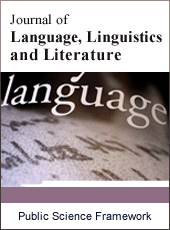Journal of Language, Linguistics and Literature
Articles Information
Journal of Language, Linguistics and Literature, Vol.4, No.3, Sep. 2018, Pub. Date: Jun. 14, 2018
The 21st Century Skills and the Role of Literature at the English Department
Pages: 34-38 Views: 2488 Downloads: 3948
[01]
Mehdaoui Ahmed, Department of English, Ibn Khaldoun University, Tiaret, Algeria.
The current global changes pose enormous challenges for the new millennium and especially for the educational system. To be effective in the 21st century, students become required more than ever to possess the combination of critical thinking, creativity, collaborative and communication skills, necessary to tackle the unexpected developments they will face. In imparting these skills, this, in return, requires teachers to apply different ways of teaching. For instance, as far as the subject of literature is concerned, teachers are required to open up huge opportunities for improving teaching and learning in the classroom. In light of this growing concern and urgency to equip our students with 21st century skills, where and how does the subject of literature at the English Department fit in? This research paper aims to discuss the possible links between 21st century skills and the subject of literature and looks at the potential of literature as a vital course of study.
English Department, Literature, Teaching Strategies, 21st Century Skills
[01]
Brumfit, C. & Carter. R (1986). Literature in the Language Teaching, Oxford: Oxford University Press.
[02]
Byram, M., Barrett, M., Lázár, L., Mompoint-Gaillard, P., & Philippou, S. (2013). Developing Intercultural Competence through Education. Strasbourg: Council of Europe Publishing.
[03]
Carroll, T. (2007). “Teaching for the Future,” Chapter 4 in Building a 21st Century U.S. Education System. National CommissiononTeachingandAmerica’sFuture.http://www.nctaf.org/resources/research_and_reports/nctaf_research_reports/documents/ Chapter4.Carroll.pdf
[04]
Carter, R. & Long (1991). Teaching Literature. Longman Handbooks for Language Teachers. New York: Longman.
[05]
Clark DB, Sampson V, Stegmann K, Marttunen M, Kollar I, Janssen J, Weinberger A, Menekse M, Erkens G, Laurinen L. Scaffolding scientific argumentation between multiple students in online learning environments to support the development of 21st century skills. Paper prepared for the Workshop on Exploring the Intersection of Science Education and the Development of 21st Century Skills, National Research Council. 2009. Available: http://www7.nationalacademies.org/bose/21CentSKillUploads.html [retrieved May 2009].
[06]
Clark, T. (2009). 21st Century Scholars. Educational Leadership, 9 (67).
[07]
Griffin, P., McGaw, B., &Care, E. (2012). Assessment and Teaching of Twenty-first Century Skills. Dprdrecht: Springer.
[08]
Lazar, G. (1993). Literature and Language Teaching. Cambridge: Cambridge University Press.
[09]
McKay, S. (1982). Literature in ESL Classroom. TESOL Quarterly, 16 (4), 529-536.
[10]
McKay, S. (2001). Literature as Content for ESL/EFL. In M. Celce-Murcia (Ed,), Teaching.
[11]
Mehdaoui, A. Instructional Strategies to Enhance Learners’ Motivation towards Learning Literature’, Journal of Education and Practice, Vol. 5, No. 30, 2014.
[12]
National Center for Education Statistics. (2003). Internet access in public schools classrooms: 1994-2003. Retrieved March 22, 2010 from http://nces.ed.gov
[13]
NCREL &Metiri Group. (2003). enGauge 21st century skills: literacy in the digital age.
[14]
Paige, J. (2009). The 21st Century Skills Movement. Educational Leadership, 9 (67).
[15]
Partnership for 21st Century Skills http://www.21stcenturyskills.org/
[16]
Silva, E. (2009). Measuring Skills for 21st-Century Learning. Phi Delta Kappan, 90 (9).
[17]
Trilling & Fadel (2009). 21st Century Learning Skills. San Francisco, CA: John Wiley & Sons.

ISSN Print: 2381-7054
ISSN Online: 2381-7062
Current Issue:
Vol. 6, Issue 1, March Submit a Manuscript Join Editorial Board Join Reviewer Team
ISSN Online: 2381-7062
Current Issue:
Vol. 6, Issue 1, March Submit a Manuscript Join Editorial Board Join Reviewer Team
| About This Journal |
| All Issues |
| Open Access |
| Indexing |
| Payment Information |
| Author Guidelines |
| Review Process |
| Publication Ethics |
| Editorial Board |
| Peer Reviewers |


